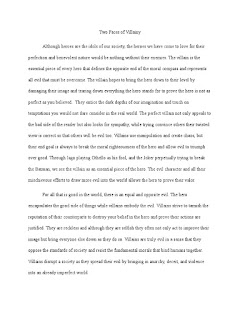The Art of Villainy: Examining the Villain Essay
When it comes to storytelling, the hero often takes center stage, captivating readers with their noble intentions and unwavering determination. However, it is the villain who adds depth and intrigue to the narrative. The villain essay, an exploration of the antagonist's role, motivations, and impact, provides a unique perspective that delves into the dark side of storytelling.
Understanding the Villain Essay
The villain essay serves as a platform to dissect and analyze the dynamics of antagonists in literature, films, and other forms of media. It allows readers to gain a deeper understanding of the villain's psychology, backstory, and overarching purpose within a given narrative.
In a villain essay, writers have the opportunity to explore how villains are crafted, how they contribute to the plot's conflict and resolution, and the techniques used to evoke various emotional responses from the audience. By examining these factors, readers can comprehend the complexities of the villain's character and appreciate their indispensable role in storytelling.
The Importance of Villains
Villains are more than just evildoers. They serve as foils to the hero, highlighting their virtues and strengths while pushing them to their limits. A well-developed villain challenges the hero's convictions, creates suspense, and fuels the narrative's tension.
Moreover, understanding a villain's motivations can provide valuable insights into the human psyche. By exploring their desires, fears, and past experiences, writers can shed light on the dark corners of society and examine the blurred lines between good and evil.
Elements of a Compelling Villain Essay
A well-written villain essay presents a comprehensive analysis that engages readers and enables them to gain a fresh perspective on the narrative. Here are some key elements to consider when writing a killer villain essay:
- In-depth Character Analysis: Explore the villain's personality traits, background, and development throughout the story.
- Motivations and Goals: Investigate what drives the villain and how their objectives relate to the protagonist.
- Impact on the Plot: Analyze the villain's role in creating conflict, driving the narrative forward, and shaping the resolution.
- Comparison to the Hero: Examine the contrasting qualities and actions of the villain in relation to the hero.
- Relevance in Popular Culture: Discuss the impact and legacy of famous villains in literature, film, or other mediums.
Final Thoughts
The villain essay provides a fascinating window into the dark side of storytelling. By carefully examining the antagonist's role, motivations, and impact, readers can gain a deeper appreciation for the complexities of a narrative, the intricate dance between good and evil, and the indispensable role of villains in captivating audiences.
So the next time you engage in a riveting tale, take a moment to reflect on the villain's journey and consider their crucial contribution to the narrative's tapestry. After all, it is often said that a story is only as good as its villain.

No comments:
Post a Comment